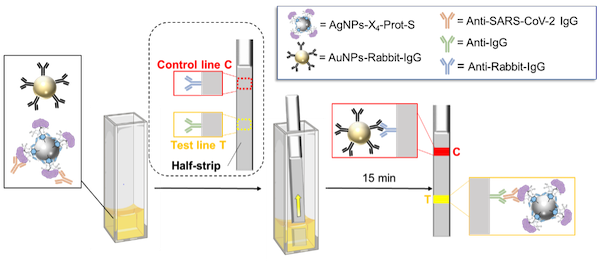Ultra-stable silver nanoparticles as promising colorimetric reporters in lateral flow immunoassays
Bryan Gosselin,1,2,# Maurice Retout,1,# Raphaël Dutour,1 Ludovic Troian-Gautier,2 Robin Bevernaegie,2 Gilles Bruylants,1,* Ivan Jabin.2,*
1 Engineering of Molecular NanoSystems, ULB, avenue F. D. Roosevelt 50, CP165/64, B-1050 Brussels, Belgium.
2 Laboratoire de Chimie Organique, ULB, Avenue F. D. Roosevelt 50, CP160/06, B-1050 Brussels, Belgium.
* Corresponding authors: Ivan.Jabin@ulb.be; Gilles.Bruylants@ulb.be # These authors made equal contributions.
Among all the point-of-care devices that have been developed over the past years, Lateral-flow Immunoassays (LFIAs) are probably the most widely used. Indeed, LFIAs combine all the POC features such as easy read-out signal (naked eyes observation), low cost and ease of use. Gold nanoparticles (AuNPs) are classically used as colorimetric reporters in LFIAs. However, current LFIAs possess a poor sensitivity (around µM) compared to ELISAs (pM to nM). To address this issue we envisaged the use of a colorimetric reporter with better optical properties than AuNPs, silver nanoparticles (AgNPs). Indeed, these latter also exhibit a LSPR band in the visible region but with an extinction coefficient one order of magnitude higher than the one of AuNPs of similar size, acting as better colorimetric reporters. If AgNPs represent thus better candidates than AuNPs for the design of LFIAs, their use has however been scarcely reported in the literature due to their poor chemical and colloidal stabilities. An efficient strategy for the building of robust and thin organic interface on various surfaces consists in using calix[4]arene-tetradiazonium salts. Indeed, these molecular platforms can be irreversibly and strongly grafted on surfaces through the reduction of their diazonium groups. Very recently, this calixarene-based coating technology has been exploited for the synthesis of ultra-stable AgNPs, much more stable than the commercial AgNPs currently available, that can be easily manipulated and conjugated to biomolecules such as proteins.
We developed an LFIA for the detection of Anti-SARS-CoV 2 IgG based on these calixarene-coated AgNPs. Our results highlight that the use of AgNPs as colorimetric reporters allows to decrease 10-fold the limit of detection in comparison to standard AuNPs while using model samples, i.e. buffer spiked with anti-SARS-Cov-2 IgG. We optimized the design of the LFIA in order to optimize the detection in a complex matrix such as human plasma with functionalized AgNPs. After optimization, we used our LFIA with clinical samples of infected patients and we obtained 100% specificity and 77% sensitivity, confirming the good performance of our system, while using far less particles of our AgNPs compared to AuNPs. Our findings are of general interest for the diagnosis field as it could pave the way to the development of improved LFIA-type applications using silver nanoparticles.

